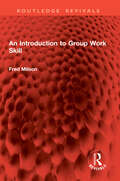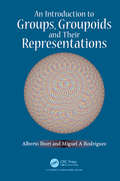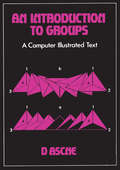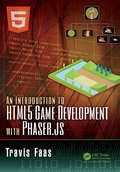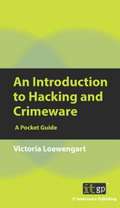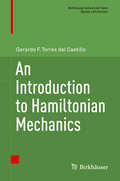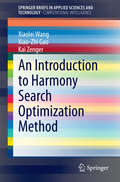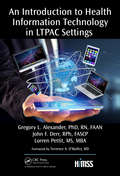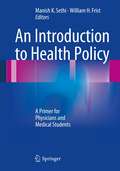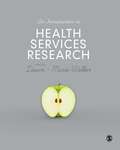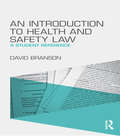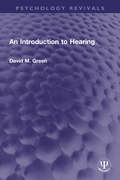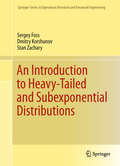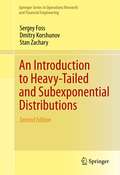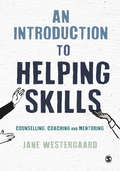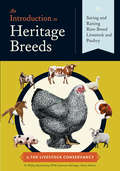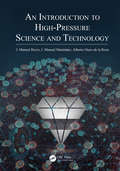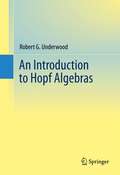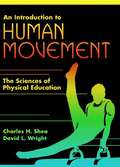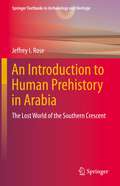- Table View
- List View
An Introduction to Group Work Skill (Routledge Revivals)
by Fred MilsonFirst Published in 1973, An Introduction to Group Work Skill is designed to make the understanding of group work skills accessible to all- mothers, teachers, employers, as well as professional social workers. Dr Milson argues that this lengthy and imaginative excursion has been thought necessary as we are here concerned with the behaviour of people in groups which meet fairly regularly, which are small enough to provide opportunities for every member to know every other member as a person, and where there is a goal to be achieved which calls for a contribution from each.The author further argues that group work skill is composed of observation, interpretation, and action, and he proceeds to analyze each of these elements in successive chapters. This is an interesting read for students of sociology of work and social work.
An Introduction to Groups, Groupoids and Their Representations: An Introduction
by Alberto Ibort Miguel A. RodriguezThis book offers an introduction to the theory of groupoids and their representations encompassing the standard theory of groups. Using a categorical language, developed from simple examples, the theory of finite groupoids is shown to knit neatly with that of groups and their structure as well as that of their representations is described. The book comprises numerous examples and applications, including well-known games and puzzles, databases and physics applications. Key concepts have been presented using only basic notions so that it can be used both by students and researchers interested in the subject. Category theory is the natural language that is being used to develop the theory of groupoids. However, categorical presentations of mathematical subjects tend to become highly abstract very fast and out of reach of many potential users. To avoid this, foundations of the theory, starting with simple examples, have been developed and used to study the structure of finite groups and groupoids. The appropriate language and notions from category theory have been developed for students of mathematics and theoretical physics. The book presents the theory on the same level as the ordinary and elementary theories of finite groups and their representations, and provides a unified picture of the same. The structure of the algebra of finite groupoids is analysed, along with the classical theory of characters of their representations. Unnecessary complications in the formal presentation of the subject are avoided. The book offers an introduction to the language of category theory in the concrete setting of finite sets. It also shows how this perspective provides a common ground for various problems and applications, ranging from combinatorics, the topology of graphs, structure of databases and quantum physics.
An Introduction to Groups: A Computer Illustrated Text (A\computer Illustrated Text Ser.)
by D AscheAn Introduction to Groups: A Computer Illustrated Text discusses all the concepts necessary for a thorough understanding of group theory. The book covers various theorems, including Lagrange and Sylow. It also details Cayley tables, Burnside's lemma, homomorphisms, and dicyclic groups. The book is ideal for advanced mathematics students and beginning undergraduates.
An Introduction to HTML5 Game Development with Phaser.js
by Travis FaasExperience the thrill of crafting your own HTML5 game with Phaser.js game engine. HTML5 and modern JavaScript game engines have helped revolutionized web based games. Each chapter in An Introduction to HTML5 Game Development with Phaser.js showcases a sample game that illustrates an aspect of Phaser.js (now Lazer.js) that can be used as is, or in remixed games of the developer’s design. Each of these examples help the reader to understand how to optimize JavaScript game development with modern project tooling like Grunt and Bower. Though the world of HTML game development continues to grow and evolve, An Introduction to HTML5 Game Development with Phaser.js, provides a grounded resource and vital learning tool to anyone looking to optimize web game development process. Key Features Chapter objectives and examples with sample code make concepts easy to grasp Master questions and chapter summaries further help to solidify these concepts Feature boxes that contain important hints and things to note help keep readers on the right path This book uses a "building blocks" approach to game development and starts with the technology required to get things running Each chapter will be a small sample game that demonstrates one piece of Phaser.js, giving the reader time to grasp and understand the core concepts Subsequent chapters will demonstrate new features, building upon the knowledge of previous examples
An Introduction to Hacking and Crimeware
by Victoria LoewengartDefend your business, protect your livelihood, safeguard your future. Cybercrime is on the rise. Unchecked, it could destroy the entire global cyber infrastructure and wipe out many businesses. We need to defend ourselves against it, and we must fight back. Toolkits to create malware are now readily available to anyone wishing to defraud and do damage. For your business to survive and thrive, it is vital to stay informed about the threats and the risks, and arm yourself against them. Know your enemyAn Introduction to Hacking & Crimeware is a comprehensive guide to the most recent and the more serious threats. Knowing about these threats will help you understand how to ensure that your computer systems are protected and that your business is safe, enabling you to focus on your core activities. Fighting backIn this pocket guide, the author:defines exactly what crimeware is _ both intentional and unintentional _ and gives specific, up-to-date examples to help you identify the risks and protect your businessexplores the increasing use of COTS tools as hacking tools, exposing the enemy_s tactics gives practical suggestions as to how you can fight backprovides a valuable list of up-to-date, authoritative sources of information, so you can stay abreast of new developments and safeguard your business.
An Introduction to Hamiltonian Mechanics (Birkhäuser Advanced Texts Basler Lehrbücher)
by Gerardo F. Torres del CastilloThis textbook examines the Hamiltonian formulation in classical mechanics with the basic mathematical tools of multivariate calculus. It explores topics like variational symmetries, canonoid transformations, and geometrical optics that are usually omitted from an introductory classical mechanics course. For students with only a basic knowledge of mathematics and physics, this book makes those results accessible through worked-out examples and well-chosen exercises.For readers not familiar with Lagrange equations, the first chapters are devoted to the Lagrangian formalism and its applications. Later sections discuss canonical transformations, the Hamilton–Jacobi equation, and the Liouville Theorem on solutions of the Hamilton–Jacobi equation. Graduate and advanced undergraduate students in physics or mathematics who are interested in mechanics and applied math will benefit from this treatment of analytical mechanics. The text assumes the basics of classical mechanics, as well as linear algebra, differential calculus, elementary differential equations and analytic geometry. Designed for self-study, this book includes detailed examples and exercises with complete solutions, although it can also serve as a class text.
An Introduction to Hand Lettering with Decorative Elements (Lettering, Calligraphy, Typography)
by Annika SauerbornA treasure trove of lettering styles and decorative elements, this handy reference offers an abundance of eye-catching alphabets, numerals, ribbons, borders, flowers, banners, and other easy-to-trace embellishments. With this guide, it's easy to add a personal touch—humorous, dramatic, or romantic—to any handwritten message or meditative journal.Hundreds of ornaments, all of them hand-drawn by the author, include dozens of alphabets and numerals. You'll also find frames, flourishes, and corner designs that provide pages with a stylish finishing touch. Decorative motifs range from arrows, hearts, and stars to leaves, blossoms, and wreaths. A wealth of fanciful graphics for special occasions includes designs for birthdays, weddings, holidays, and all four seasons. Calligraphers, crafters, and illustrators as well as anyone who wants to add a bit of pizzazz to their writing will prize this imaginative source of inspiration.
An Introduction to Harmony Search Optimization Method (SpringerBriefs in Applied Sciences and Technology)
by Xiaolei Wang Xiao-Zhi Gao Kai ZengerThis brief provides a detailed introduction, discussion and bibliographic review of the nature1-inspired optimization algorithm called Harmony Search. It uses a large number of simulation results to demonstrate the advantages of Harmony Search and its variants and also their drawbacks. The authors show how weaknesses can be amended by hybridization with other optimization methods. The Harmony Search Method with Applications will be of value to researchers in computational intelligence in demonstrating the state of the art of research on an algorithm of current interest. It also helps researchers and practitioners of electrical and computer engineering more generally in acquainting themselves with this method of vector-based optimization.
An Introduction to Health Information Technology in LTPAC Settings (HIMSS Book Series)
by Gregory L. Alexander, PhD, RN, FAAN Derr F. John, RPh, FASCP Lorren Pettit, MS, MBAA multiplicity of factors converging together suggest the long term/post-acute care (LTPAC) provider community (e.g. nursing homes, behavioral health facilities, home health agencies, etc.) will accelerate in importance within the healthcare ecosystem during the next few years. The challenge for many LTPAC providers in this emerging environment will be to advance their clinical health information technologies (health IT) capabilities in order to "play" with other providers in the healthcare "sandbox." This book is designed to assist LTPAC leaders in identifying and exploring the array of critical issues one needs to consider in order to operate within an advanced clinical health IT ecosystem. This book surveys key issues surrounding the use of clinical health IT in LTPAC settings, to include providing readers with a suggested strategic plan and roadmap for selecting and installing digital health technologies in LTPAC organizations. Though the focus of the book primarily centers on the U.S. LTPAC provider’s experience, the authors also spend time addressing global and future LTPAC considerations.
An Introduction to Health Policy: A Primer for Physicians and Medical Students
by William H. Frist Manish K. SethiBased on the current climate of our nation's finances and healthcare spending, it is clear that young doctors and medical students are likely to see a dramatic transformation of the manner in which America offers medical care to its citizens over the course of their careers. As such, it is pivotal that the next generation of America's leaders on the front lines of medicine develop a sense of where healthcare has evolved from and future potential directions of change. An Introduction to Health Policy: A Primer for Physicians and Medical Students is the first of its kind: a book written by doctors for doctors in order to allow busy physicians and medical students to quickly develop an understanding of the key issues facing American healthcare. This book seeks to efficiently and effectively educate physicians and medical students in a clinical context that they can understand on the past, present, and potential future issues in healthcare policy and the evolution of American healthcare. The reader will walk away from the book with the ability to discuss the fundamental issues in American healthcare with ease.
An Introduction to Health Services Research: A Practical Guide
by Dawn-Marie WalkerThis is a primary, comprehensive textbook for people who are considering undertaking a piece of health-related research. It is an accessible companion with the aim of getting the reader to think broadly about all of the issues that need to be considered when embarking on a project. This is a pragmatic book, a step-by-step guide to research which mirrors the structure of a research project, taking you through the thought process for designing and conducting your study from formulating the right research question at idea inception, ascertaining what methodologies and analysis can answer what type of questions, right through to dissemination, all presented in an easy, digestible style. The book is full of case study illustrations and practical tips such as how to work out a research budget and obtaining funding for your project, discussion of what permissions need to obtained when conducting research with people, and how to involve public and patients. The authors are all experienced researchers and so this book is an accumulation of collective wisdom on common research challenges and issues.
An Introduction to Health and Safety Law: A Student Reference
by David BransonAn Introduction to Health and Safety Law provides a clear, concise overview of health and safety law in the United Kingdom. With reference to the European Union, this book discusses criminal and civil liability at length to provide a clear understanding of this area of law which has been subject to change over the 20 years. Key case studies and statistical information on prosecutions, fines and enforcement notices help to contextualise health and safety law to provide students and professionals with a full understanding of health and safety law in the UK. This book includes chapters on: the legal framework criminal liability enforcement of criminal liability civil liability civil remedy subordinate legislation. This book is an essential reference for students studying towards NEBOSH qualifications and students studying at university level. It provides a comprehensive understanding of UK health and safety law and will be a useful reference when entering the professional field.
An Introduction to Hearing (Psychology Revivals)
by David M. GreenOriginally published in 1976, this introduction to hearing was intended to provide a sufficient introduction to each of several subareas of hearing so that the serious student can read the more advanced treatments with greater appreciation and understanding. It was intended for upper graduate and graduate students. It assumes some mathematical sophistication – calculus for example, but there is some review of more basic concepts, such as logarithms. There is also a brief treatment of the necessary material from the different disciplines – physics, physiology, psychology, anatomy and mathematics – that a student of hearing will need to know.
An Introduction to Heavy-Tailed and Subexponential Distributions (Springer Series in Operations Research and Financial Engineering #38)
by Dmitry Korshunov Stan Zachary Sergey FossHeavy-tailed probability distributions are an important component in the modeling of many stochastic systems. They are frequently used to accurately model inputs and outputs of computer and data networks and service facilities such as call centers. They are an essential for describing risk processes in finance and also for insurance premia pricing, and such distributions occur naturally in models of epidemiological spread. The class includes distributions with power law tails such as the Pareto, as well as the lognormal and certain Weibull distributions.<P><P> This monograph defines the classes of long-tailed and subexponential distributions in one dimension and provides a complete and comprehensive description of their properties. New results are presented in a simple, coherent and systematic way. This leads to a comprehensive exposition of tail properties of sums of independent random variables whose distributions belong to the long-tailed and subexponential class.<P> The book includes a discussion of and references to contemporary areas of applications and also contains preliminary mathematical material which makes the book self contained. Modelers in the fields of finance, insurance, network science and environmental studies will find this book to be an essential reference.
An Introduction to Heavy-Tailed and Subexponential Distributions, 2nd Edition (Springer Series in Operations Research and Financial Engineering)
by Dmitry Korshunov Stan Zachary Sergey FossHeavy-tailed probability distributions are an important component in the modeling of many stochastic systems. They are frequently used to accurately model inputs and outputs of computer and data networks and service facilities such as call centers. They are an essential for describing risk processes in finance and also for insurance premia pricing, and such distributions occur naturally in models of epidemiological spread. The class includes distributions with power law tails such as the Pareto, as well as the lognormal and certain Weibull distributions.<P><P> One of the highlights of this new edition is that it includes problems at the end of each chapter. Chapter 5 is also updated to include interesting applications to queueing theory, risk, and branching processes. New results are presented in a simple, coherent and systematic way.<P> Graduate students as well as modelers in the fields of finance, insurance, network science and environmental studies will find this book to be an essential reference.
An Introduction to Helping Skills: Counselling, Coaching and Mentoring
by Jane WestergaardReaders will be introduced to the three core approaches of counselling, coaching and mentoring, and shown how they work across a variety of settings, including therapy, teaching, social work and nursing. Part 1 takes readers through the theory, approaches and skills needed for helping work, and includes chapters on: The differences and similarities of counselling, coaching and mentoring Foundational and advanced skills for effective helping Supervision and reflective practice Ethical helping and working with diversity Part 2 shows how helping skills look in practice, in a variety of different helping professions. 10 specially-written case studies show you the intricacies of different settings and client groups, including work in schools, hospitals, telephone helplines and probation programs.
An Introduction to Helping Skills: Counselling, Coaching and Mentoring
by Jane WestergaardReaders will be introduced to the three core approaches of counselling, coaching and mentoring, and shown how they work across a variety of settings, including therapy, teaching, social work and nursing. Part 1 takes readers through the theory, approaches and skills needed for helping work, and includes chapters on: The differences and similarities of counselling, coaching and mentoring Foundational and advanced skills for effective helping Supervision and reflective practice Ethical helping and working with diversity Part 2 shows how helping skills look in practice, in a variety of different helping professions. 10 specially-written case studies show you the intricacies of different settings and client groups, including work in schools, hospitals, telephone helplines and probation programs.
An Introduction to Heritage Breeds: Saving and Raising Rare-Breed Livestock and Poultry
by Alison Martin D. Phillip Sponenberg DVM Jeannette BerangerDeveloped for the particular needs of the working farm, heritage breeds have proved invaluable to small-scale agricultural production for centuries. This comprehensive guide explains why conserving heritage breeds remains important and how they often can be a better choice for the modern farmer than conventional animals. With profiles of heritage poultry, sheep, cattle, and more, you’ll learn how to select and successfully raise the breed that is right for your specific needs. Enjoy the benefits of resilient livestock while preserving genetic diversity for future generations.
An Introduction to High-Pressure Science and Technology
by Alberto Otero de la Roza J. Manuel Recio J. Manuel MenéndezAn Introduction to High-Pressure Science and Technology provides you with an understanding of the connections between the different areas involved in the multidisciplinary science of high pressure. The book reflects the deep interdisciplinary nature of the field and its close relationship with industrial applications.Thirty-nine specialists in high
An Introduction to Hilbert Space
by Nicholas YoungThis textbook is an introduction to the theory of Hilbert spaces and its applications. The notion of a Hilbert space is a central idea in functional analysis and can be used in numerous branches of pure and applied mathematics. Dr. Young stresses these applications particularly for the solution of partial differential equations in mathematical physics and to the approximation of functions in complex analysis. Some basic familiarity with real analysis, linear algebra and metric spaces is assumed, but otherwise the book is self-contained. The book is based on courses given at the University of Glasgow and contains numerous examples and exercises (many with solutions). The book will make an excellent first course in Hilbert space theory at either undergraduate or graduate level and will also be of interest to electrical engineers and physicists, particularly those involved in control theory and filter design.
An Introduction to Holocaust Studies
by Michael Bernard-DonalsThis single volume traces three approaches to the study of the Holocaust - through notions of history, theories of memory, and a focus on art and representation. It introduces students to the different ways we have come to understand the Holocaust, gives them an opportunity to ask questions about those conclusions, and examines how this event can be understood once all the survivors are gone. In addition, the book looks at the different disciplines - history, sociology, religious studies, and literary interpretation, among others - through which studies of the Holocaust take place.
An Introduction to Homological Algebra
by Charles A. WeibelThe landscape of homological algebra has evolved over the past half-century into a fundamental tool for the working mathematician. This book provides a unified account of homological algebra as it exists today. The historical connection with topology, regular local rings, and semi-simple Lie algebras is also described. The first half of the book takes as its subject the canonical topics in homological algebra: derived functors, Tor and Ext, projective dimensions and spectral sequences. Homology of group and Lie algebras illustrate these topics. Intermingled are less canonical topics, such as the derived inverse limit functor lim1, local cohomology, Galois cohomology, and affine Lie algebras. The last part of the book covers less traditional topics that are a vital part of the modern homological toolkit: simplicial methods, Hochschild and cyclic homology, derived categories and total derived functors.
An Introduction to Hopf Algebras
by Robert G. UnderwoodWith wide-ranging connections to fields from theoretical physics to computer science, Hopf algebras offer students a glimpse at the applications of abstract mathematics. This book is unique in making this engaging subject accessible to advanced undergraduate and beginning graduate students. After providing a self-contained introduction to group and ring theory, the book thoroughly treats the concept of the spectrum of a ring and the Zariski topology. In this way the student transitions smoothly from basic abstract algebra to Hopf algebras. The importance of Hopf orders is underscored with applications to algebraic number theory, Galois module theory and the theory of formal groups. By the end of the book, readers will be familiar with established results in the field and ready to pose research questions of their own.
An Introduction to Human Movement
by Charles H. Shea David L. WrightThis new book is designed for the newly developing curriculum emerging in the field of Physical Education Exercise Science. Today, there is a renewed interest and dedication to the scientific study of human movement. This is reflected in the trend for physical education programs to change their names to departments of Kinesiology, Exercise and Sport Sciences, Human Movement, etc. This book captures this shift in the field of physical education by covering each of the sub-disciplines related to the study of human movement at an introductory level. For professionals in the field of physical education.
An Introduction to Human Prehistory in Arabia: The Lost World of the Southern Crescent (Springer Textbooks in Archaeology and Heritage)
by Jeffrey I. RoseThis textbook explores the mystery of human origins in the Arabian Peninsula, the lost Southern Crescent where humanity took its first steps toward civilization. Under Arabia’s surface of sand and stone lies a primordial realm of rolling grasslands, freshwater lakes, and river floodplains. This book aims to restore a critical missing chapter in the prehistory of our species that played out in this forgotten place of plenty. The author has carried out more than twenty years of fieldwork in Yemen and Oman, weaving his research together into an unorthodox tapestry of archaeology, environmental science, genetics, and Middle Eastern mythology. This volume peers beneath Arabia’s abandoned deserts, revealing a land that once served as a bridge between prehistoric worlds. This textbook is suitable for undergraduate and graduate students as well as all readers who are interested in learning about Arabian prehistory.
